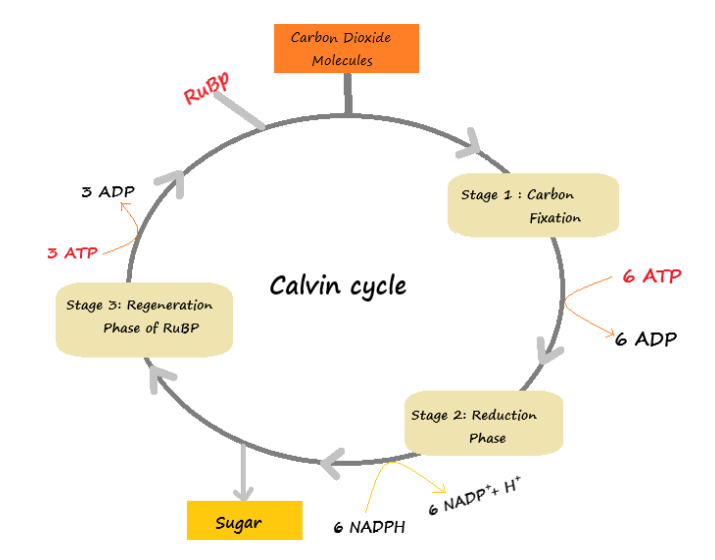
The name, Melvin Calvin is associated with
A. Synthesis of ATP during photosynthesis
B. Release of water during photosynthesis
C. Carbon fixation during photosynthesis
D. Capture light during photosynthesis
Answer
556.5k+ views
Hint: Melvin Ellis Calvin was an American biochemist. He was awarded the Nobel Prize in Chemistry for his significant work regarding the discovery of the Calvin cycle.
Step by step answer:Photosynthesis is the process of conversion of carbon dioxide and water into carbohydrates using light energy sources by plants. It was definite that this was the outcome, but for centuries scientists could not figure out the exact procedure. Melvin Calvin was the first person to evaluate and exhibit the photosynthetic process. This process was named after him and was called the Calvin cycle. Plants and algae synthesize carbon dioxide from the air into carbohydrates (sugar) for their growth and development. Almost every living being on earth depends on the Calvin cycle for food and energy. Animals with a plant-based diet are called herbivores. They solely derive energy and food from plants. Therefore, herbivores indirectly depend on the Calvin cycle.
The Calvin cycle can be defined as a metabolic pathway, wherein the carbon enters the chloroplast stroma in the form of carbon dioxide and exits in the form of sugars. The cycle utilizes Adenosine triphosphate as the energy source. It consumes NADPH$_2$ as a reducing agent. This collectively allows the formation of sugars by the addition of high energy electrons.

Melvin Calvin carried out the experiment to determine the steps involved in carbon fixation through photosynthesis in the Old Radiation Labs, a wooden building located on the Berkeley campus. He germinated the aquatic living organism, green algae as they use photosynthesis due to the presence of chloroplast. He then proceeded to entrap the algae in a contraption device that he describes as “the lollipop.” He utilized carbon-14, a radioactive form of carbon to trace the path of the carbon through the stroma of the algae’s chloroplast as this is where photosynthesis takes place. He did this by shining a light on the lollipop. He determined the carbon pathway through this method.
The Calvin cycle constitutes of the following steps:
1. Carbon fixation
2. Reduction Phase
3. Regeneration Phase
In conclusion to the specifications delivered, the name Melvin Calvin is associated with carbon fixation during photosynthesis.
Note: Greenhouse gases contribute to the increasing risks of global warming. Carbon fixation can assist in the removal of excess greenhouse gases from the atmosphere. The Calvin cycle can be defined as a metabolic pathway, wherein the carbon enters the chloroplast stroma in the form of carbon dioxide and exits in the form of sugars.
Step by step answer:Photosynthesis is the process of conversion of carbon dioxide and water into carbohydrates using light energy sources by plants. It was definite that this was the outcome, but for centuries scientists could not figure out the exact procedure. Melvin Calvin was the first person to evaluate and exhibit the photosynthetic process. This process was named after him and was called the Calvin cycle. Plants and algae synthesize carbon dioxide from the air into carbohydrates (sugar) for their growth and development. Almost every living being on earth depends on the Calvin cycle for food and energy. Animals with a plant-based diet are called herbivores. They solely derive energy and food from plants. Therefore, herbivores indirectly depend on the Calvin cycle.
The Calvin cycle can be defined as a metabolic pathway, wherein the carbon enters the chloroplast stroma in the form of carbon dioxide and exits in the form of sugars. The cycle utilizes Adenosine triphosphate as the energy source. It consumes NADPH$_2$ as a reducing agent. This collectively allows the formation of sugars by the addition of high energy electrons.

Melvin Calvin carried out the experiment to determine the steps involved in carbon fixation through photosynthesis in the Old Radiation Labs, a wooden building located on the Berkeley campus. He germinated the aquatic living organism, green algae as they use photosynthesis due to the presence of chloroplast. He then proceeded to entrap the algae in a contraption device that he describes as “the lollipop.” He utilized carbon-14, a radioactive form of carbon to trace the path of the carbon through the stroma of the algae’s chloroplast as this is where photosynthesis takes place. He did this by shining a light on the lollipop. He determined the carbon pathway through this method.
The Calvin cycle constitutes of the following steps:
1. Carbon fixation
2. Reduction Phase
3. Regeneration Phase
In conclusion to the specifications delivered, the name Melvin Calvin is associated with carbon fixation during photosynthesis.
Note: Greenhouse gases contribute to the increasing risks of global warming. Carbon fixation can assist in the removal of excess greenhouse gases from the atmosphere. The Calvin cycle can be defined as a metabolic pathway, wherein the carbon enters the chloroplast stroma in the form of carbon dioxide and exits in the form of sugars.
Recently Updated Pages
Why are manures considered better than fertilizers class 11 biology CBSE

Find the coordinates of the midpoint of the line segment class 11 maths CBSE

Distinguish between static friction limiting friction class 11 physics CBSE

The Chairman of the constituent Assembly was A Jawaharlal class 11 social science CBSE

The first National Commission on Labour NCL submitted class 11 social science CBSE

Number of all subshell of n + l 7 is A 4 B 5 C 6 D class 11 chemistry CBSE

Trending doubts
10 examples of friction in our daily life

One Metric ton is equal to kg A 10000 B 1000 C 100 class 11 physics CBSE

Difference Between Prokaryotic Cells and Eukaryotic Cells

1 Quintal is equal to a 110 kg b 10 kg c 100kg d 1000 class 11 physics CBSE

State the laws of reflection of light

Explain zero factorial class 11 maths CBSE




